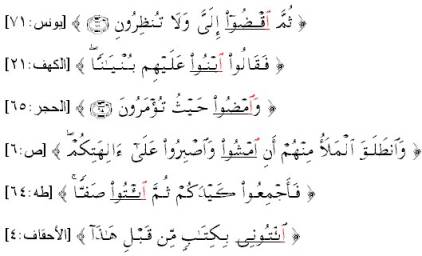Hamzah
Al-Wasl

Lesson
3
 in
verbs (continued)
in
verbs (continued)
In
the last tidbit lesson, we described the different types of verbs that hamzah
al-wasl enters as a first letter.
Please
refer to Hamzah Al-Wasl lesson 2 in the tidbit archives to review this lesson.
It
was stated last lesson that hamzah al-wasl may enter, as a first letter,
past
tense five and six letter basic make up verbs, and the command
tense in basic
make of three, five, and six letters verbs.
The
Vowel of the Hamzah Al-Wasl when beginning with it in verbs
The
vowel of
 when
beginning with it, in verbs, depends on the vowel on the
when
beginning with it, in verbs, depends on the vowel on the
third letter of the
verb. NOTE:
The is considered a letter when counting the letters;
is considered a letter when counting the letters;
a
letter with a shaddah is counted as two letters.
There are two possible vowels when starting
with
 in
verbs.
in
verbs.
1.
A dhammah
2.
A kasrah
Starting
verbs with a dhammah on the hamzah al-wasl
1.
The hamzah-t al-wasl has a dhammah
on it when beginning the word starting with it
if the third letter of the verb has a required or original dhammah
(meaning the dhammah is
part of the original verb not an acquired one).
Examples
of this in past tense verbs are shown in the following aayaat:



If
we look at the verb:
 from aayah 26 of surah Ibraheem, we see that
there is a hamzah wasl
from aayah 26 of surah Ibraheem, we see that
there is a hamzah wasl
as the first letter.
As stated previously, we need to count three letters to the left,
counting the hamzah al-wasl
as the first letter. We
can see then, that the
 is
the third letter, and it has a dhammah on it.
is
the third letter, and it has a dhammah on it.
This is an original dhammah and we therefore start this word with a
dhammah on the hamzah al-wasl.
Remember,
we only use the hamzah al-wasl when starting the word.
If we are reading in continuum with the
words before this verb, we
would drop the hamzah al-wasl and join directly the vowel on the last letter
of the word before
 .
.
Examples
of this in the command form of verbs are shown in the following aayaat:


Starting
verbs with a kasrah on the hamzah al-wasl
We
begin hamzah al-wasl in a verb with a kasrah
when in the following cases:
A)
If the third letter
of the verb has an original kasrah. This
is exemplified in the following aayaat:


B)
When the third letter of the verb has a fat-h .
This is demonstrated in the following
aayaat:


C)
When the third letter of the verb has a presented dhammah. It
is to be noticed that in these next six examples shown below the dhammah is a
presented one due to the plurality of the command form of the verb that has an
harf ‘ila
 ,
(either an alif, ya’ or wow) as
the last letter in the essential make up of the verb.
When these verbs are the plural command form, there would have been a
ya’ saakinah followed by a wow saakinah which is quite heavy for the tongue,
so the Arabs drop the ya’ saakinah in these forms of the verb, and the third
letter acquires a presented dhammah. These
are the only five verbs in the Qur’an that have a presented dhammah in the
third letter, but it should be noted that some of these verbs occur in the
Qur’an in different forms of the same verb.
. As stated previously, when starting with one of these six
verbs, we start with a kasrah not a dhammah.
,
(either an alif, ya’ or wow) as
the last letter in the essential make up of the verb.
When these verbs are the plural command form, there would have been a
ya’ saakinah followed by a wow saakinah which is quite heavy for the tongue,
so the Arabs drop the ya’ saakinah in these forms of the verb, and the third
letter acquires a presented dhammah. These
are the only five verbs in the Qur’an that have a presented dhammah in the
third letter, but it should be noted that some of these verbs occur in the
Qur’an in different forms of the same verb.
. As stated previously, when starting with one of these six
verbs, we start with a kasrah not a dhammah.

When
starting with the word
 it
is read as “
it
is read as “ ”
employing the rule of medd al-bedl which was previously discussed, which is:
whenever there are two hamzahs next to each other in one word, the first
voweled and the second non-voweled, the second hamzah is changed to a medd
letter from the same type as the vowel on the first hamzah.
Therefore, since the first hamzah now has a kasrah, the second hamzah,
which is saakinah, will change into a lengthened ya’.
”
employing the rule of medd al-bedl which was previously discussed, which is:
whenever there are two hamzahs next to each other in one word, the first
voweled and the second non-voweled, the second hamzah is changed to a medd
letter from the same type as the vowel on the first hamzah.
Therefore, since the first hamzah now has a kasrah, the second hamzah,
which is saakinah, will change into a lengthened ya’.
Still
another item to be noticed is that if the
conjunctive
 which
means “and” precedes a verb that begins with a hamzah al-wasl, or another conjunctive
letter such a
which
means “and” precedes a verb that begins with a hamzah al-wasl, or another conjunctive
letter such a
 and
we are beginning with this verb, we must begin with the
and
we are beginning with this verb, we must begin with the
 or
or
 due to its
strong link to the verb. We
therefore read the wow with a fath, then continue reading the verb. We do not
apply the
due to its
strong link to the verb. We
therefore read the wow with a fath, then continue reading the verb. We do not
apply the  rules
in this case. An example of
this is in the following:
rules
in this case. An example of
this is in the following:

